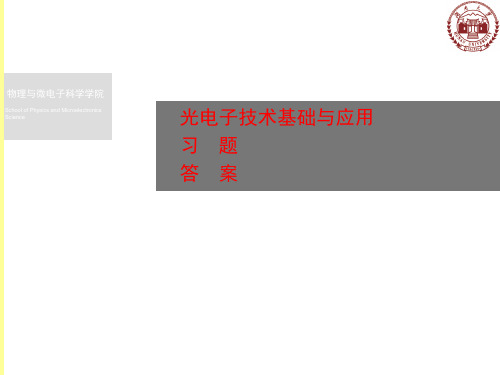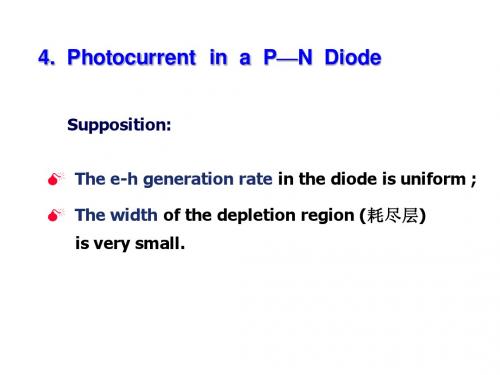光电子学课后习题chapter2&3
- 格式:pdf
- 大小:205.52 KB
- 文档页数:20


第一章1.10 Refractive index(a) Consider light of free-space wavelength 1300 nm traveling in pure silica medium. Calculate the phase velocity and group velocity of light in this medium. Is the group velocity ever greater than the phase velocity?(b) What is the Brewster angle(the polarization angle qp) and the critical angle(qc) for total internal reflection when the light wave traveling in this silica medium is incident on a silica/air interface. What happens at the polarization angle?(c) What is the reflection coefficient and reflectance at normal incidence when the light beam traveling in the silica medium is incident on a silica/air interface?(d) What is the reflection coefficient and reflectance at normal incidence when a light beam traveling in air is incident on an air/silica interface? How do these compare with part (c) and what is your conclusion?1.18 Reflection at glass-glass and air-glass interfaceA ray of light that is traveling in a glass medium of refractive index n1=1.460 becomes incident on a less dense glassmedium of refractive index n2=1.430. Suppose that the free space wavelength of the light ray is 850 nm.(a) What should the minimum incidence angle for TIR be?(b) What is the phase change in the reflected wave when the angle of incidence qi =85 ° and when qi =90° ?(c) What is the penetration depth of the evanescent wave into medium 2 when qi =85 ° and when qi =90° ?(d) What is the reflection coefficient and reflection at normal incidence (qi =0 ° )when thelight beam traveling in the glass medium (n=1.460) is incident on a glass-air interface?(e) What is the reflection coefficient and reflectance at normal incidence when a light beam traveling in air is incident on an air/-glass interface (n=1.460)? How do these compare with part (d) and what is your conclusion?1.20 TIR and polarization at water-air interface(1) Given that the refractive index of water is about 1.33, what is the polarization angle for light traveling in air and reflected from the surface of the water?(2) consider a diver in sea pointing a flashlight towards the surface of the water. What is the critical angle for the light beam to be reflected from the water surface?1.22 phase changes on TIRConsider a lightwave of wavelength 870nm traveling in a semiconductor medium (GaAs) of refractive index 3.6. It is incident on a different semiconductor medium (AIGaAs) of°. Will this result in total internal refractive index 3.4, and the angle of incidence is 80reflection? Calculate the phase change in the parallel and perpendicular components of the reflected electric field?1.25 Goos-Haenchen phase shiftAray of light that is traveling in a glass medium(1) of refractive index n1 =1.460 becomes incident on a less dense glass medium(2) of refractive index n2=1.430. Suppose that the free space wavelength of the light ray is 850nm.the angle of incidence(9=85 . Estimate the lateral Goos-Haenchen shift in the reflected wave for the perpendicular field component. Recalculate the Goos-Haenchen shift in the secondmedium has n2=1 (air). What is your conclusion?Assume that the virtual reflection occurs from a virtual plane in medium B at a distance d that is roughly the same as the penetration depth.Note that d actually depends on the polarization ,the direction of the field,but we will ignore this dependence.第二章作业习题:2.7Dielectric slab waveguide Consider a dielectric slab waveguide that has a thin GaAs layer of thickness 0.25 /w between two AIGaAs layers. The refractive index of GaAs is3.6 and that of the AIGaAs layers is 3.40. What is the cut-off wavelength beyond which only a single mode can propagate in the waveguide, assuming that the refractive index does not vary greatly with thewavelength? If a radiation of wavelength 860 nm (corresponding to bandgap radiation) is propagating in the GaAs layer, what is the penetration of the evanescent wave into the AIGaAs layer? What is the mode field width (MFW) of this radiation? Point out the effect of change of radiation wavelength (为on the MFW.2.9 Dielectric slab waveguide Consider a planar dielectric waveguide with a core thickness 10/m,ni=1.4446, n2=1.4440. Calculate the V -number, the mode angle 劣for m=0 (use a graphical solution, if necessary), penetration depth, and mode field distance (MFW=2 c(^2 9, for light wavelengths of 1.0 /xn and 5 /jn. What is your conclusion? Compare your MFW calculationwith 2»o =2a (V +1 )/V .The model angle 3is given as &=88.85?for ^=1 /m and ^=88.72 ?for ^=1.5 仰for the fundamental mode m=0.2.10 A multimode fibe r Consider a multimode fiber with a core diameter of 60 /m, core refractive index of 1.47, and a cladding refractive index of 1.45 both at 870 nm. Consider operating this fiber at ^=870nm.(e) Calculate the numerical aperture.(f) Find out the normalized core-cladding index difference.(g) Calculate the V-number for the fiber and estimate the number of guided modes.(h) Calculate the wavelength beyond which the fiber becomes single-mode.(i) Calculate the modal dispersion △ T and hence the bit rate x distance product.2.12 Single mode fiber Consider a fiber with a S1O2-13.5% GeOz core of diameter of 6 Wi and refractive index of 1.47 and a cladding refractive index of 1.46 both refractive indices at 1300 nm where the fiber is to be operated using a laser source with a half maximum width (FWHM) of 2 nm.. (j) Calculate the V -number for the fiver.(k) what is the maximum allowed diameter of the core that maintains oprations in single-mode?(l) Calculate the wavelength below which the fiber becomes multimode.(m) C alculate the numerical aperture.(n) Calculate the maximum acceptance angle.(o) Obtain the material dispersion and wavelength dispersion and hence estimate the bit rate x distance product ( B x L) of the fiber.。

光电子技术及应用(第2版)章节习题及自测题参考答案第一章习题参考答案一、单选题1.ABCD2.ABC3.ABC4.D5.B6.C7.B8.B9. A 10.A二、填空题11.500,30012.无线电波,.红外光,可见光和紫外光,X 射线,γ射线13.0.77---1000μm ,近红外,中红外和远红外14.泵浦源,谐振腔和激活介质15.频率,相位,振幅及传播方向16.受激辐射,实现粒子数反转,谐振腔;方向性好,相干性好,亮度高 17.935μm18.919.125103.1--⋅⋅⨯s m kg20.三、计算题21.解:(1)根据距离平方反比定律2/R I E e e =,太阳的辐射强度为sr W R E I e e /10028.3252⨯==。
得到太阳的总功率为W I e e 26108.34⨯==Φπ(2)太阳的辐射亮度为()sr cm W A I L e ./10989.127⨯== 太阳的辐射出射度为27/1025.6m W L M e e ⨯==π 太阳的温度为K M T e 57614==σ22.解:222z r r ='=,22cos cos z r z+'='=θθ,r d r dS '∆'=ϕ 由:2cos cos r BdS S d d dE θθ'='Φ'=2202222022)(2cos 2z R RB z r r d r z B r d r r B E R R+=+'''=''=⎰⎰ππθπ 23.解:设相干时间为τ,则相干长度为光束与相干时间的乘积,即c L c ⋅=τ 根据相干时间和谱线宽度的关系c L c v ==∆τ1 又因为00γλλv ∆=∆,λc v =0,nm 8.6320=λ由以上各关系及数据可以得到如下形式:单色性=101200010328.6108.632-⨯===∆=∆nm nm L v v c λλλ 24.证明:若t=0时刻,单位体积中E 2能级的粒子数为n 20,则单位体积中在t→t+dt 时间内因自发辐射而减少的E2能级的粒子数为:2122122120A t dn A n dt A n e dt --==故这部分粒子的寿命为t ,因此E2能级粒子的平均寿命为212120020211A t tA n e dtn A τ∞-==⎰ 25.解:设两腔镜1M 和2M 的曲率半径分别为1R 和2R ,121m,2m R R =-=工作物质长0.5m l =,折射率 1.52η=根据稳定条件判据:(1) 其中(2) 由(1)解出2m 1m L '>>由(2)得所以得到: 2.17m 1.17m L >>第二章习题参考答案011 1 21L L ''⎛⎫⎛⎫<-+< ⎪⎪⎝⎭⎝⎭() l L L l η'=-+10.5(1)0.171.52L L L ''=+⨯-=+一、选择题1.ABCD2.D3.ABCD4.AC5.ABCD6.A7.A8.A9.A 10. B二、 是非题911.√ 12.× 13.× 14.× 15.√ 16.√三、 填空题17.大气气体分子及气溶胶的吸收和散射;空气折射率不均匀;晶体介质的介电系数与晶体中的电荷分布有关,当晶体被施加电压后,将引起束缚电荷的重新分布,并导致离子晶格的微小形变,从而引起介电系数的变化,并最终导致晶体折射率变化的现象。



光电子学与光子学的原理及应用第二章-课后答案1. 选择题1.1 题目一答案:C解析:光电效应是指物质受到光的照射后,吸收光能,将光能转化为电能的一种现象。
光电效应首先是由爱因斯坦在1905年提出的,他在描述光电效应时,引入了光子概念,假设光是由一组个别粒子组成的(即光量子),这些粒子就是后来被称为光子的电磁辐射量子。
1.2 题目二答案:A解析:光电倍增管是指通过光电效应,在光电面上光电发射物质外壳的钨丝和灯管之间加一个高达2000-3000伏的电压使其产生光电流,再对光电流进行电子倍增,最后输出检测的一种光电探测器。
光电倍增管的结构与普通的电子管相似,但是在各个电极和玻璃壳之间加入了紧密和高度真空的保护,同时在阳极和阳极网之间还添加了一个用直流电压加电的光电体。
当阳极对外加正电压使阳极电流开始增大时,就成为光电倍增管。
1.3 题目三答案:D解析:光电二极管是一种能够将光信号转化为电信号的器件。
光电二极管的基本原理是利用半导体材料的PN结在光照射下产生光电效应,使得PN结两端产生电荷,从而产生电压信号。
光电二极管的结构和普通二极管类似,主要由P型和N型的半导体材料组成,当光照射到光电二极管上时,光子能量被半导体材料所吸收,产生的热力激发电子,从而引起半导体PN结的载流子的复合和流动,产生感光电流。
光电二极管应用广泛,如光通信、光电测量、光谱分析等领域。
1.4 题目四答案:B解析:光导纤维是一种能够传输光信号的特殊纤维材料。
光导纤维的核心部分是由高折射率的材料构成,而外部由低折射率的材料构成。
当光线传输到光导纤维中时,会发生全反射现象,使得光线能够沿着光导纤维进行传输,最终到达目标地点。
光导纤维具有传输距离远、损耗小、带宽大、抗电磁干扰等优点,在通信、医疗、传感等领域得到广泛应用。
2. 填空题2.1 题目一答案:钠解析:钠具有低电离电势,激发电子的能量比较低,是光电电子极容易脱离的材料之一。
2.2 题目二答案:光电效应解析:光电效应是指物质受到光的照射后,吸收光能,将光能转化为电能的一种现象。
课后作业绪论1.显示技术的分类;阐述CRT、LCD、PDP、EL、FED各自的特点。
2.掌握显示技术的常见参数。
1.光通量:指能够被人的视觉系统所感知的那一部分光量2.发光强度:一光源在单位立体角内所发出的光通量称为光源在该方向上的发光强度,单位3.亮度:指光源在某个方向的单位投影面积,单位立体角中辐射的光通量4.彩色5.对比度6.效率:驱动功率、分辨率;光输出效率(流明效率);发光材料的效率(量子效率)7.响应速度8.存储性能9.寿命、视角第一章阴极射线管显示1、CRT的基本组成由那些?电子枪(Electron Gun),偏转线圈(Defiection coils),荫罩(Shadow mask),荧光粉层(Phosphor)及玻璃外壳2、什么是电子聚焦??分别解释静电场和磁场聚焦原理一束发散角不大的带电粒子束,当它们在磁场B的方向上具有大致相同的速度分量时,它们有相同的螺距。
经过一个周期它们将重新会聚在另一点,这种发散粒子束会聚到一点的现象与透镜将光束聚焦现象十分相似,因此叫磁聚焦3、CRT扫描方式有哪些?其工作原理是什么按电子束运动的规则可分为光栅扫描、圆扫描、螺旋扫描等隔行(interlaced)和逐行(progressive)电子束在通过两个偏转磁场时,在荧光屏上做从上到下、从左到右的匀速往复直线扫描动动。
我们将一行紧跟一行的抚摸方式称为逐行扫描,在逐行扫描过程中,其图像信号的时间顺序与空间顺序是一致的。
隔行扫描即是把一帧分为两场来扫描,每秒扫描50场。
规定奇数行1,3,5,7…573(显示行,其它为场逆程非显示行)的场为奇数场,偶数行2,4,6,…574的场为偶数场。
若采用奇、偶两场均匀相互嵌套的话,即可以获得高的清晰度,又能保证每帧扫描起点相同,两场的扫描锯齿电流规律相同,大大降低了对扫描电路的要求。
4、三基色混色原理有那些?并分别列出几种混色关系?三基色的本质是三基色具有独立性,三基色中任何一色都不能用其余两种色彩合成。
第二章:⒉在玻璃( 2.25,1)r r εμ==上涂一种透明的介质膜以消除红外线(0.75)m λμ=的反射。
⑴求该介质膜应有的介电常量及厚度。
⑵如紫外线(0.42)m λμ=垂直照射至涂有该介质膜的玻璃上,反射功率占入射功率百分之多少?⑴1.5n = 正入射时,当n =时,膜系起到全增透作用5 1.225n ==,正入射下相应的薄膜厚度最薄为 00.750.15344 1.225h m nλμ===⨯⑵正入射时,反射率为222200002222000022()cos ()sin 22()cos ()sin G G G G n n nhnhn n n n n n nh nhn n n n ππλλρππλλ-+-=+++正220022220002()cos 3.57%22()cos ()sin G G G nhn n n n nhnhn n n n πλππλλ-==+++⒌一束波长为0.5 m μ的光波以045角从空气入射到电极化率为20.6j +的介质表面上,求⑴此光波在介质中的方向(折射角)。
⑵光波在介质中的衰减系数。
⑴2123n =+=n = 由112sin sin n n θθ=得2sin 6θ=2arcsin 6θ= ⑵衰减系数72(0.6)0.6 1.310nr k πλ=-⨯-=⨯=⨯⒍输出波长λ=632.8nm 的He-Ne 激光器中的反射镜是在玻璃上交替涂覆ZnS 和2ThF 形成的,这两种材料的折射率系数分别为1.5和2.5。
问至少涂覆多少个双层才能使镜面反射系数大于99.5%?设玻璃的折射率G n =1.5 由题意: 02220220()0.995()P H H LG P H H L Gn n n n n n n n n n λρ⎡⎤-⎢⎥⎢⎥=≥⎢⎥+⎢⎥⎣⎦正,,即22222.5 1.51()1.5 1.50.99752.5 1.51()1.5 1.5P P -≤-+ 即 250.0025() 1.5 1.99753P ⨯⨯≥25()532.73P≥ 212.3P = 7P ≈ 故至少涂覆7个双层。